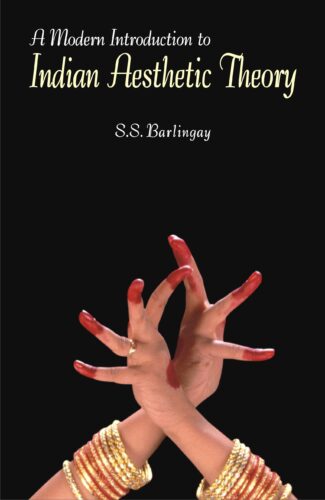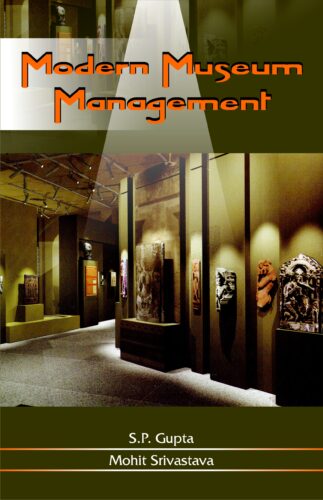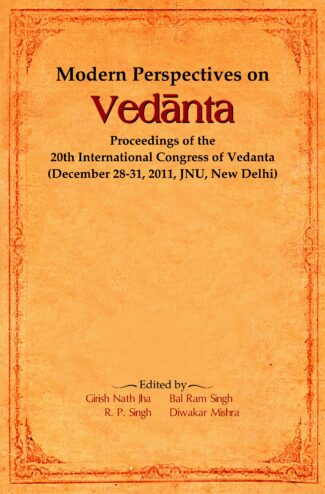Showing 601–610 of 1165 results

This volume attempts to negotiate with some of the unmitigated issues frequently raised, debated and discussed in the domain of Anglo-American Analytic Philosophy. Viewpoints of some of the major philosopher like W.V.O. Quine, Ruth Barcan Marcus, Pranab Kumar Sen, David Wiggins and Ludwig Wittgenstein along with many others have come up for discussion and elaboration.
This volume includes ten essays written by Prof. Indrani Sanyal in different phases of her long academic career. Essays collected in this volume document the authors attempt to negotiate with some of the unmitigated issues frequently raised, debated and discussed in the domain of Anglo-American Analytic Philosophy. Viewpoints of some of the major philosophers like W.V.O. Quine, Ruth Barcan Marcus, Pranab Kumar Sen, David Wiggins and Ludwig Wittgenstein along with many others have come up for discussion and elaboration.
The first six essays of this volume deal directly with the issues relating to modal logic, quantification, essence and possible worlds. In the next three essays, the author has discussed the viewpoints of the earlier Wittgenstein and later Wittgenstein on logical space, limits of language and the nature of understanding. The last essay of this volume concentrates on the idea of structural universals and debates centring its feasibility.
The book has been written in a clear and lucid language without forgoing the required technicalities of the subject matter. Anybody interested in Philosophy in general and Philosophical Logic and metaphysics in particular will find the volume to be interesting. Scholars and researchers will be definitely benefitted by this volume.
The crisis of the age inheres in this, that notwithstanding the century’s mind-numbing disasters, it persists in subscribing to propositions which have logically led to the atomization of the whole cloth of human experiencing, and being. Great indeed is the value which is placed on the procedure of analytic dismemberment. While the method has certainly been result-producing, materially, in its wake it has brought immense suffering – both physical and spiritual. The price paid for a lopsided advance is thirty major wars – with their toll of one hundred and thirty million lives, and the irreparable destruction of the natural environment. The time demands a reappraisal of the basic paradigms of human existence, but the hegemony of well-entrenched vested interests – material or intellectual – would seem to preclude this.
The “advanced” people among the mankind of the day become suicidally specialized. For, if the mechanical model of thought has been of advantage in man’s preceding unfolding, the same, what may be called the “survival” paradigm, now creates dangerous dualities, binary oppositions (you–me, body–mind, East–West, etc). The model has outlived its usefulness merely enforcing dormancy on a major part of the human brain.
It behoves mankind to choose wisely right now – since parallel to the socio-economic, scientific and technological revolutions there has got to be the overdue radical psychic transformation. The first step towards clearing the fateful crisis would therefore be to be aware and end the hold of the linear, causal, mechanical thought orientation over the intellectual culture of the times.
Delving deep into the epistemological cum ontological causation of the emergency confronting the being and becoming of man, this volume provokes the thoughtful lay reader to a serious engagement with his or her self.

All arts in India owe their roots to the theoretical structure developed by Bharatamuni in his celebrated work Natyasastra. His theory of beauty is known as the theory of rasa. The present volume has shown how the insight of Bharata was developed by the classical scholars from Abhinavagupta to Jagannatha who propounded the theories with names like rasa, alamkara, riti, vakrokti, dhvani etc. to employ the theory of beauty from natya (drama) to kavya (poetry).
The foundation of the Indian aesthetic theory can be traced to Bharatamunis Natyashastra where he gave his theory of beauty (theory of rasa) which was later elaborately developed by learned scholars. In this work, Prof. Barlingay examines the development of the rasa theory by various authorities on art and aesthetics and finally presents his own critical understanding of it. The volume begins with a survey of the history of Indian art by examining painstakingly the relation between art and beauty, perception of time and space in art, and classification of arts. It then plunges into a detailed study of origin and development of rasa theory: from rasa in the Vedas and Upanishads to Bharatas rasa theory and perspectives of Abhinavagupta, Bhattatauta, Bhatta Lollata, Kuntaka, Dandin, Mammata, Vamana, Rudrata, Vishvanatha, Bhamaha, Jagannatha and others who enriched it further with their own theories. It explains how principles were employed and re-employed by the masters to reveal various meanings, inter-relationships, symbols, and perceptions of art. It highlights the salient features of each masters unique manner of interpretation of art concepts. The work is a must for scholars and students keen to study the fundamentals of concept and theory of Indian art, particularly with reference to drama and poetics.

All arts in India owe their roots to the theoretical structure developed by Bharatamuni in his celebrated work Natyasastra. His theory of beauty is known as the theory of rasa. The present volume has shown how the insight of Bharata was developed by the classical scholars from Abhinavagupta to Jagannatha who propounded the theories with names like rasa, alamkara, riti, vakrokti, dhvani etc. to employ the theory of beauty from natya (drama) to kavya (poetry).
The foundation of the Indian aesthetic theory can be traced to Bharatamunis Natyashastra where he gave his theory of beauty (theory of rasa) which was later elaborately developed by learned scholars. In this work, Prof. Barlingay examines the development of the rasa theory by various authorities on art and aesthetics and finally presents his own critical understanding of it. The volume begins with a survey of the history of Indian art by examining painstakingly the relation between art and beauty, perception of time and space in art, and classification of arts. It then plunges into a detailed study of origin and development of rasa theory: from rasa in the Vedas and Upanishads to Bharatas rasa theory and perspectives of Abhinavagupta, Bhattatauta, Bhatta Lollata, Kuntaka, Dandin, Mammata, Vamana, Rudrata, Vishvanatha, Bhamaha, Jagannatha and others who enriched it further with their own theories. It explains how principles were employed and re-employed by the masters to reveal various meanings, inter-relationships, symbols, and perceptions of art. It highlights the salient features of each masters unique manner of interpretation of art concepts. The work is a must for scholars and students keen to study the fundamentals of concept and theory of Indian art, particularly with reference to drama and poetics.

This book scholarly examines various aspects of Museology and Museography. It discusses the origin of the word museum its definition, types of museums, museum architecture, museum management and maintenance, famous museums of the world, besides the educational role of museums.
This book is a scholarly effort to examine various aspects of Museology and Museography. It discusses the origin of the word museum its definition, types of museums, famous museums of the world that have developed since the eighteenth century and the development of museums in India. It deals with the educational role of museums: its provision of non-formal, visual, recreational education through creating awareness by its various activities. It is concerned with different aspects of museum architecture. In a detailed study of museum management and maintenance, it takes up the mode of collection, documentation, exhibition and conservation of diverse items, as well as museum ethics and museum security. A special effort has been made to clarify the terms and concepts like marketing, orientation, evaluation, communication and administration which are deeply related to museums. The book deals with the role of some international organisations and conventions with regard to collection and preservation of materials. The attempt has been to simplify the subject and present its methodologies with clarity. This book will interest students of Museology and Conservation as also Museum Professionals as it provides useful guidelines about Curatorship.

This volume is a compendium of highly insightful papers presented by leading and promising scholars at the 20th intenational Congress of Vedanta. The papers discuss a variety of topics ranging from the origin of the universe to the Vedàntic perspective on the spiritual quest and science as also the essence of Vedànta and its relevance to modern times.
Vedanta has retained its fundamental ideas as enshrined in the Upanishads over the centuries. But it is still extremely relevant in addressing the contemporary problems of globalised and liberalised societies. It is in this context that the Vedanta Congress has met at regular intervals to debate and discuss challenges faced by contemporary societies.
This volume presents a compilation of papers presented at the Twentieth International Congress of Vedanta, held at the Jawaharlal Nehru University, New Delhi. The papers cover a variety of topics in English, Hindi and Sanskrit: philosophy of the origin of the universe, the behaviour of matter, social structures, political systems, role of language, yoga and meditation, among others. The insightful papers discuss the Advaita concept of testimonial perception, the concept of maya, the notion of time and space in the cosmology of the Samkhya system of philosophy and the Vedantic perspective on the spiritual quest and science. They deal with the nature and theory of origin of varna in the Bhagavad-Gita, Vedantic perception of organisational behaviour, importance of Vedanta in the corporate world, and value systems in governance with reference to Indian dharmic perspectives. These papers also highlight the essence of Vedanta as it applies to modern philosophy, science and business and the influence it exerts on culture, language and lives of people in India and the world.
The volume will prove valuable to scholars and students of Indology, religion and philosophy, particularly researchers of Vedanta and its relevance to modern times.

The book endeavours in recounting the mode in which Mohammed accomplished a tedious task of constructing a state and an empire out of the Arab tribes. It attempts to do justice to his intellectual ability and to observe towards him the respectful attitude which his greatness deserves. The volume is neither an apology nor an indictment.
The standpoint from which this book is written suggests and regards Mohammed as a great man, who solved a political problem of appalling difficulty – the construction of a state and an empire out of the Arab tribes. The book endeavours in recounting the mode in which Mohammed accomplished this, to do justice to his intellectual ability and to observe towards him the respectful attitude which his greatness deserves. The volume is neither an apology nor an indictment.
As far as the fecundity of the content is concerned, the book has taken a cue from different Arab sources and many scholarly works of earlier historians, efforts of many European scholars on Mohammedan antiquities and Islamic traditions. In condemning traditions unhistorical, the book has ordinarily considered the obelus of scholars like Ignaz Goldziher, Thodor Noldeke and Julius Wellhausen sufficient.

This well-illustrated volume seeks to explain an enigmatic and paradoxical symbolism common to many of the world religions, both polytheistic and monotheistic that of the cavernous maw of a great monster. Drawing on a broad array of comparative evidence, including examples from Hindu, Buddhist, Jewish, Christian and Islamic religions, it delves on the cross-cultural points of contact that may have contributed to the spread of such zoomorphic hybrids from Turkey, the Caucasus and Iran to the Indian Subcontinent.
This well-illustrated volume seeks to explain an enigmatic and paradoxical symbolism common to many of the world religions, both polytheistic and monotheistic that of the cavernous maw of a great monster. Drawing on a broad array of comparative evidence, including examples from Hindu, Buddhist, Jewish, Christian and Islamic religions, it delves on the cross-cultural points of contact that may have contributed to the spread of such zoomorphic hybrids from Turkey, the Caucasus and Iran to the Indian Subcontinent.
Straddling the boundaries between popular and textual traditions the gaping jaws of a great monster is a mythical paradigm of the bivalence of a deep-seated historic force: the yawning orifice of all-consuming death can as well symbolize the power of life or generative power. This dual force can also be reflected in an abbreviated conceptualization visualized on opposite sides of a common axis. The outcome of the symbolic synthesis, which axiomatically unifies such vast, inexorably linked, seemingly irresistible potent forces, thus may suggest different shades of meaning daunting, and yet again singularly attracting, humbling and at the same time exalting.
This book should arouse keen interest among all those interested in the comparative perspective of religious, cultural and artistic history.

This volume presents the detailed diagrams of plans of over 380 of temples, tombs, palaces and pavilions found in the Indian subcontinent and the Indianised states of Java, the Khmer, Pagan, Thailand, Vietnam and Malaysia. The book also containing brief notes of each plan will be useful for scholars and students of Buddhist, Hindu and Islamic architecture with particular reference to South Asian and South-East Asian regions.
This volume presents the plans of temples, tombs, palaces and pavilions found in the Indian subcontinent and the Indianised states of Java, the Khmer, Pagan, Thailand, Vietnam and Malaysia. They contain detailed diagrams of plans of over 380 structures along with a brief note on each plan that covers the various segments/sections of each monument. The plans are precise and are presented along with their elevations which are proportional, i.e., depict major architectural forms and masses. The monuments covered, of the period third century bc to ce 1854, pertain to different regions of India and different periods and dynasties in Indian history. They include famous structures like the cave monasteries at Ajanta, Sanchi temples, Rajasthani temples, the Lal Qila and the Taj Mahal as well as other lesser-known buildings. Monuments of the Mughals, the Sultanate kings, the Lodis, Tughlaqs and Vijayanagar kings are among the Indian structures included. The book will be useful for scholars of Buddhist, Hindu and Islamic architecture with particular reference to South Asian and South-East Asian regions.

Its 100 quotes on Moods and Emotions empower us to mitigate the bad effects of our behaviour and inculcate in us the healthy emotional persuits. Each quote is in tandem with a stimulating painting of Lord Ganesha, the Lord of Peace, Prosperity and Wisdom, and helps us to overcome many a crisis in our life.
This book of 100 quotes on Moods and Emotions empowers one to mitigate the bad effects of one’s behaviour and inculcate in him/her the healthy emotional persuits. Each quote is in tandem with a stimulating painting of Lord Ganesha, the Lord of Peace, Prosperity and Wisdom. Many wise men and women have worked on these wonderful concepts of behaviour and blessed the world with a number of thought-provoking and enlightening quotes for one to lead a cheerful and healthy life. The authors too join these great personalities with their own creations.
Mood is basically a psychological condition indicating one’s positive or negative state of mind. Emotion, per se, is a complex psycho-physiological experience of an individual’s state of mind and has its direct link with mood, temperament, personality, disposition and motivation. Emotions act as an effective component to motivation, which direct and energize one’s behaviour. These quotes help the readers to manage their moods and emotions with a positive attitude.
| There are no products |